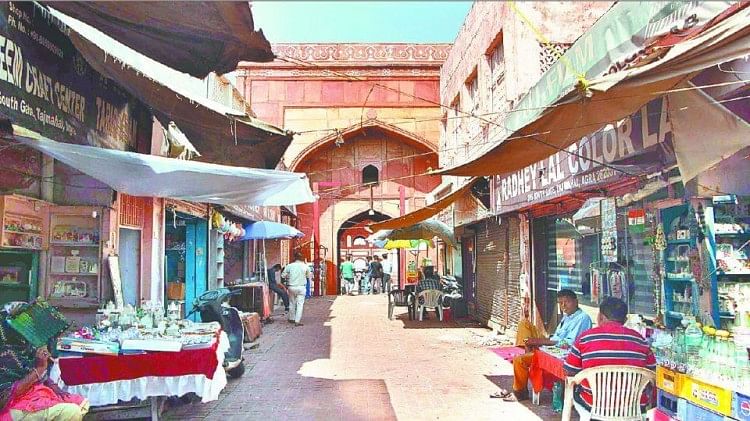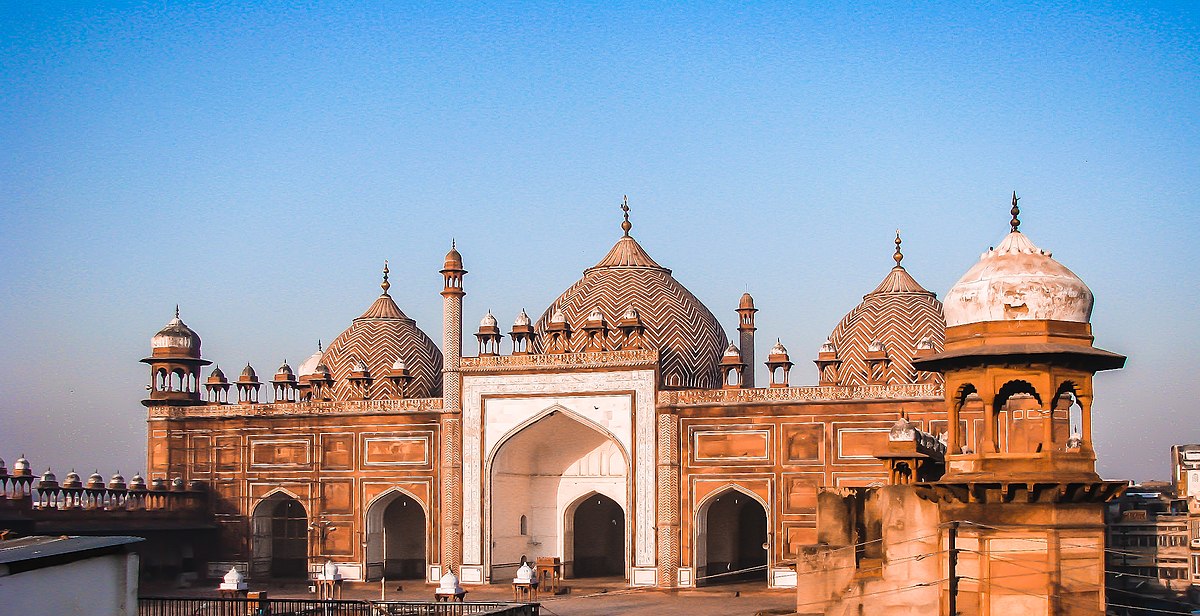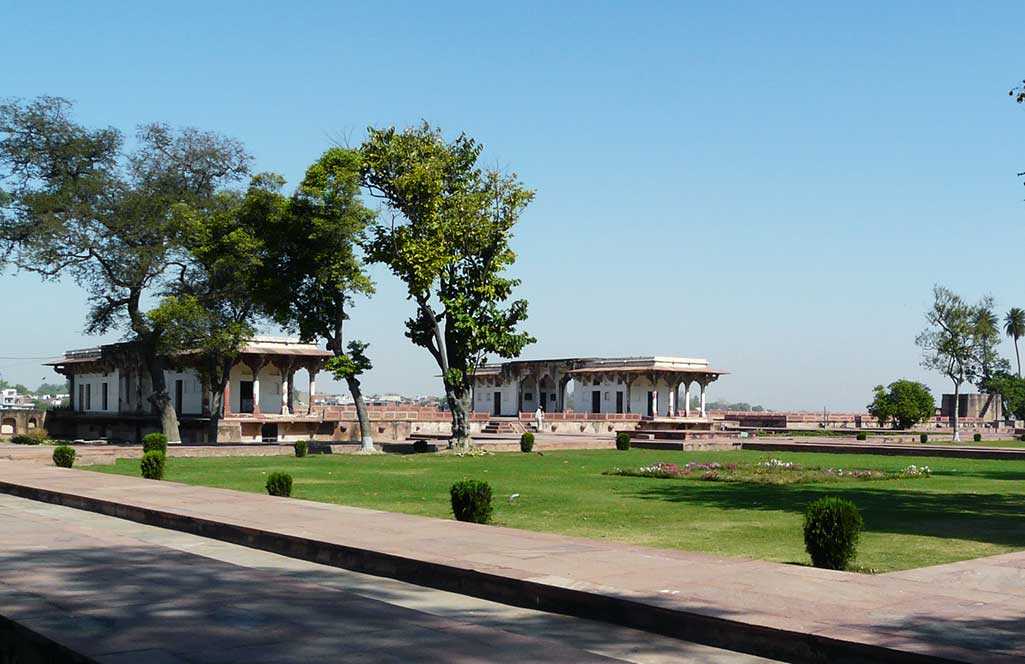The heritage city of Agra stands as one of the most mesmerizing Halal-friendly travel destinations and ranks among the world’s most frequently visited locales.
A journey to India remains incomplete without an expedition to this splendid city, which boasts three UNESCO World Heritage sites. Among them, one has been internationally acclaimed as the “Wonder of the World.” The Taj Mahal, an unparalleled exemplar of Indo-Islamic architecture, stands as a universally revered masterpiece within the realm of world heritage. A multitude of travelers from across the globe converge on Agra to witness this iconic marvel.

Delving into the annals of history, the genesis of Agra reveals a profoundly rich historical tapestry. This city’s cultural, artistic, and religious heritage has evolved over centuries, leaving an indelible mark on its identity. The roots of this imperial capital stretch back to antiquity, with Agra’s origins harkening to a bygone era. Agra is, in essence, an ancient town, its nomenclature harking back to “Agrabana” or “Agravana,” a sylvan expanse described in the epic Mahabharata.






Agra first stepped into the medieval spotlight when Sikandar Lodhi, the ruler of the Delhi Sultanate, made the monumental decision to transfer his capital from Delhi to Agra in the early 16th century.
The historical significance of Agra burgeoned under the rule of Sikandar Lodi. In 1504, Sultan Sikandar Lodi, an Afghan potentate of the Delhi Sultanate, undertook the monumental task of reconstructing Agra, designating it as the seat of government. Nestled on the banks of the River Yamuna, the city swiftly evolved into a nexus of power, drawing royal dignitaries, merchants, scholars, theologians, and artists. Agra, in this epoch, ascended as the foremost bastion of Islamic scholarship in India.
Upon Sultan Sikandar Lodi’s passing, the city passed into the hands of his son, Sultan Ibrāhīm Lodī. He presided over his Sultanate from Agra until his fateful demise in combat against Babur, a Timurid prince and ruler from Central Asia, in the decisive Battle of Panipat fought in 1526.


Babur, originally Mīrzā Zahīr ud-Dīn Muhammad, was the progenitor of the Mughal Empire in the Indian subcontinent. He boasted lineage tracing back to Timur from his father’s line and Genghis Khan from his mother’s. Following Babur’s tenure, his successor, Mughal Emperor Humayun, or Nasir-ud-Din Muhammad, ascended to the throne in 1530. However, his reign was interrupted in 1540 by Afghan Ruler Farid Khan, known as Sher Shah Suri, who founded the Sur Empire in India. Agra remained under Suri rule until Emperor Humayun’s recapture in 1555-1556.

Following Humayun, his son, Mughal Emperor Akbar, full name Abu’l-Fath Jalal-ud-din Muhammad Akbar, assumed leadership. He was succeeded by his son, Mughal Emperor Jahangir, originally known as Nur-ud-Din Muhammad Salim, and later by his grandson, Mughal Emperor Shahjahan, originally named Shihab-ud-Din Muhammad Khurram. Under the Mughal dynasty’s reign, Agra etched its place in the annals of world history, becoming an enduring symbol of grandeur and cultural significance.
Agra blossomed into a grand canvas, portraying the splendor of Mughal rule in India, becoming one of the foremost cities of medieval India. The Mughals’ reign endured from 1526 to 1858 AD, marking the most opulent, enduring Muslim dynasty to govern India. This dynasty birthed the pinnacle of refined arts and architecture among Muslim dynasties in Indian history.
Agra unfolded as an expansive canvas, vividly portraying the splendid era of Mughal rule in India. It grew into one of the most pivotal cities of medieval India, basking in the glory of Mughal grandeur. The Mughals held sway over India from 1526 to 1858 AD, marking their dynasty as the most illustrious, opulent, and enduring Muslim dynasty to govern the subcontinent. This remarkable dynasty left an indelible mark, producing the most exquisite and refined arts and architecture in the history of Muslim dynasties in India.


Mughal Emperor Babar, the visionary behind the Mughal dynasty, crafted the first formal Persian garden along the Yamuna’s banks known as the Aram Bagh or the Garden of Relaxation. His grandson, Mughal Emperor Akbar, fortified the towering walls of the Great Red Fort and transformed Agra into a hub for education, the arts, trade, and spirituality. Akbar’s initiatives also led to the creation of a new township on the outskirts of Agra, Fatehpur Sikri. Jahangir, Akbar’s son, had an ardent passion for painting, music, architecture, and the natural world. He safeguarded artists and established a workshop that welcomed artisans of his preference, adorning the Agra Fort with unique gardens.
Among the landmarks of historical and architectural significance in Agra are the Tomb of Mughal Emperor Akbar and the Tomb of Itmad-Ud-Daulah, both completed during the reign of Mughal Emperor Jahangir. Following Jahangir, his son, Mughal Emperor Shah Jahan, renowned for his deep interest in architecture, gifted the city its most prized monument—the Taj Mahal. Constructed in adoring memory of his wife Mumtaz Mahal, originally known as Arjumand Banu Begum, the Taj Mahal stands as an eternal symbol of love and architectural splendor.
Following the decline of the Mughal Empire, Agra saw a shift in power dynamics with the ascendance of the Marathas and later the British. The successors of the Mughal Dynasty lacked the strength to reclaim Agra and were primarily confined to Delhi. The Marathas held authority over Agra in 1570 before eventually ceding control to the British in the early 1800s. As this transition unfolded, the historical city of Agra gradually waned in both luster and significance, losing the prominence it once enjoyed during the Mughal Era.



While the city no longer holds the same political sway and prominence it once did, its iconic history reverberates not only within the walls of the Taj Mahal but also amidst the labyrinthine alleys and humble eateries serving sumptuous Mughlai cuisine. Though the monarchs and rulers have long departed from Agra’s stage, the cultural legacy they bestowed upon the town persists, ingrained in the very fabric of this renowned city.


Today, Agra stands as a sought-after tourist destination, primarily celebrated for its legendary monuments, many of which are UNESCO World Heritage sites. The heritage city completes a popular tourist circuit, internationally renowned as the ‘golden triangle tour of India,‘ encompassing Delhi and Jaipur. While the enchanting allure of the Taj Mahal draws global visitors to Agra, the city’s heritage extends beyond this singular marvel, offering a tapestry of captivating architectural wonders waiting to be explored.
The Agra Fort, a sprawling UNESCO World Heritage site spanning 380,000 square meters, stands as a remarkable monument intertwined with various rulers and conflicts. Mughal Emperor Akbar, upon assuming the throne, designated Agra as his capital upon arriving in 1558.

Renowned historian Abul Fazl chronicled that the fort, initially a dilapidated brick structure known as Badalgarh, was reconstructed by Akbar using red sandstone. A workforce of approximately 4,000 laborers toiled daily for eight years, culminating in the fort’s completion in 1573. The Mughal Dynasty retained it as their capital until 1638 when the capital was relocated from Agra to Delhi. It was also acknowledged as the Qila-i-Akbari.

Fatehpur Sikri, also known as the “City of Victory,” stands as a UNESCO World Heritage site merely 40 kilometers from Agra.

It serves as an extraordinary testament to the pinnacle of Indo-Islamic architectural brilliance, established by Mughal Emperor Akbar. Its design and layout significantly influenced the trajectory of Indian town planning, serving as the capital of the Mughal Empire for approximately a decade. The ensemble of monuments, all constructed in a consistent architectural style, portrays the quintessential Mughal walled city, delineating distinct private and public domains alongside grand gateways. Despite Emperor Akbar’s initial intentions to establish this city as his capital, the dearth of water resources compelled him to relinquish its usage.

It is widely believed that Mughal Emperor Akbar ventured to the village of Sikri to seek counsel from the revered Sufi saint, Hazrat Shaikh Salim Chishti, who prophesied the birth of an heir to the Mughal throne. When the prophecy materialized, Akbar chose to establish his new capital here, a complex that boasted a grand array of monuments. Among these were one of India’s largest mosques, three opulent palaces, and a multitude of architectural marvels. In reverence to Hazrat Sheikh Salim Chishti, Akbar initiated the construction of a sacred complex. A particularly distinctive feature was the white marble tomb of Hazrat Sheikh Salim Chishti, enclosed within the courtyard of the Jama Masjid.

The monumental complex at Fatehpur Sikri houses the remarkable Buland Darwaza, a towering structure soaring 180 feet above the ground. Adorning the archway are inscriptions bearing a profound message: “Isa, Son of Mariam said; The world is a bridge, pass over it, but build no houses on it. He who hopes for an hour may hope for eternity. The world endures but an hour. Spend it in prayer, for the rest is unseen.” These words encourage people not to view the world as a permanent abode and to refrain from placing excessive hope in worldly possessions, emphasizing the transient nature of human life. Carved in Naskh script along the top are verses from the Quran, further enriching the spiritual and philosophical essence of the monument.

The Sikandra Tomb stands as the mausoleum of Mughal Emperor Akbar. Interestingly, Akbar himself chose the tomb’s site, devised its design, and oversaw the construction, even adorning the vicinity with a stunning garden during his lifetime. However, the exquisite marble upper portion of the mausoleum was completed by his son, Mughal Emperor Jahangir.

The Itmad-ud-Daulah Tomb is celebrated as one of the most exquisite Mughal tombs. Constructed during the reign of Mughal Emperor Jahangir, this tomb enshrines the cenotaphs of Mirza Ghiyas and Asmat Begum, parents of Mughal Empress Nur Jahan, the wife of Emperor Jahangir, originally named Mehr-un-Nissa Bagum.

Many believe that the Itmad-ud-Daulah Tomb served as an inspiration for the Taj Mahal, earning it the moniker “Baby Taj Mahal.”

The Chini Ka Rauza is a mausoleum dedicated to Mullah Shukrullah Shirazi, honored with the royal title Afzal Khan, who served as a Mughal courtier during the reigns of Mughal Emperor Jahangir and Shah Jahan. This monument is situated amidst meticulously kept gardens and is distinguished by its striking blue-glazed tiles.

The tiles used in the construction of Chini Ka Rauza are crafted from porcelain, often referred to as Chini Mitti or Chinese Clay. The site stands as an early proponent of an exotic Persian art style, serving as a captivating introduction to this distinctive artistic heritage.

The Tomb of Mariam stands as a tribute to the beloved wife of Mughal Emperor Akbar, commonly and inaccurately referred to as ‘Jodha Bai’. Originally a Rajput Princess named Heer Kunwari, she wed Akbar in 1562 and was renamed Mariam-uz-Zamani Bagum. She bore Mughal Emperor Jahangir and, consequently, was the grandmother of Mughal Emperor Shah Jahan. Jahangir, in honor of his mother, constructed a tomb in close proximity to Akbar’s tomb.
The Jama Masjid of Agra, one of the largest mosques commissioned by the Mughals in India, features a rectangular open forecourt, erected in 1648 by Jahanara Begum, the daughter of Mughal Emperor Shah Jahan. The mosque’s construction demanded the labor of approximately 5,000 workers and concluded within a span of six years.


The Aram Bagh, a Mughal garden envisioned by Emperor Babur, was established in 1528. It’s believed that Babur was briefly interred here before his remains were transported to Kabul in Afghanistan.

Mehtab Bagh, another creation by Emperor Babur, is a stunning garden situated in close proximity to the Taj Mahal. This garden complex boasts a square layout and is meticulously aligned with the Taj Mahal, creating a harmonious and complementary setting.
The legacy of Agra’s artisans is truly extraordinary. Over the centuries, skilled craftsmen and artisans from diverse corners of the world congregated here, collaborating to craft magnificent structures and art. Remarkably, these creative styles have been preserved and perpetuated through the generations within the same artisan families. Their expertise spans a wide array of skills, encompassing intricate carving, cutting, inlaying, polishing, and the transformation of raw marble blocks into the exquisite designs that adorn Agra today.


Observing these artisans at work is an otherworldly experience, a testament to their unparalleled skill and dedication. It’s an unparalleled addition to an Agra trip, offering an immersive journey through rich living history, replete with intriguing stories and inspiring individuals who breathe life into art each day.


Agra’s traditional cuisine beautifully resonates with its Mughal heritage. Mughlai cuisine, in particular, is a hallmark of the city’s culinary identity. This style of cooking often features meat dishes infused with creamy, robustly flavored gravies, abundant in dried fruits and a rich blend of aromatic spices. Visitors can delight in a variety of Mughal-inspired dishes available in numerous restaurants across the city, each offering its take on these exquisite flavors.


Discover the true essence of India with us, one of the prime destinations for Halal-friendly travelers. Embark on an enchanting Halal-friendly trip that unveils the irresistible charm of India, adorned with a myriad of mesmerizing Muslim-friendly travel destinations.
Destination India offers an extensive array of options to curate a memorable Halal-friendly travel experience, meticulously tailored for Halal holidays. Immerse yourself in the rich tapestry of cultural heritage and the tranquility of nature’s serene beauty.
India is a treasure trove of Islamic heritage, where the captivating fusion of Indo-Islamic art and culture unfolds. Its diverse landscapes are adorned with iconic cities and towns, each bearing witness to the profound influence of Islamic art and architectural wonders.
Be enthralled by magnificent structural marvels, unearth the secrets of ancient towns and bustling cities, and wander through princely forts, opulent palaces, and vibrant bazaars. These historic places, steeped in architectural significance, enjoy global acclaim.
Explore the enchanting beauty and heritage of Agra, a true jewel among Halal-friendly destinations in India. Embark on a journey that meanders through the rich tapestry of Islamic cultural opulence, where every step echoes the footsteps of history and captures breathtaking beauty. Immerse yourself in the captivating Halal voyage through one of the world’s most visited destinations.
Embark on enchanting Muslim family holidays and group tours in Agra, immersing yourself in its authentic essence amidst breathtaking landscapes and awe-inspiring Indo-Islamic architectural and cultural heritage.
Explore our well-crafted Muslim-friendly tour itineraries to Agra and unparalleled Halal tour packages, designed to offer an unforgettable Halal holiday experience and cater to Muslim group travel needs. Immerse yourself in the serene beauty of India’s natural wonders and rich Islamic cultural heritage while enjoying a seamless travel experience throughout your trip.
Discover the captivating allure of India as an enchanting destination tailored for Muslim-friendly tours, highlighted by its array of Halal-friendly travel destinations and amenities, ideal for Muslim group tours and family holiday trips. India proudly presents a rich tapestry of Islamic heritage tours woven into a great fusion of Indo-Islamic art and culture. Moreover, a multitude of cities and towns across India, imbued with rich Islamic heritage and architectural significance, hold esteemed positions among the globe’s most visited destinations.
With diverse landscapes ranging from serene lakes, vibrant beaches, pristine backwaters, and picturesque valleys to majestic mountains and charming hill resorts with natural wonders that are beyond imagination. India’s wildlife parks and tiger reserves provide exceptional opportunities to observe exotic wildlife in their natural habitats. Many places in India are hailed as some of the world’s most beautiful, ensuring a consistently Halal-friendly environment throughout your travels.
At HalalTrip India, we take immense pride in being the most trusted Halal travel guide for Muslim travelers seeking the best of Halal-friendly tourism in India. We are dedicated to ensuring a seamless and unparalleled Muslim-friendly travel experience throughout India.
Join the countless Halal-friendly travelers who have entrusted us to provide the finest Halal travel experience in India. Allow us to be your reliable travel partner as you unveil the true essence of India and create cherished memories that will last a lifetime.
Write us – travel@HalalTripIndia.com
Follow us – www.facebook.com/IndianHalalTourism
Follow us – https://www.instagram.com/halaltripindia/




